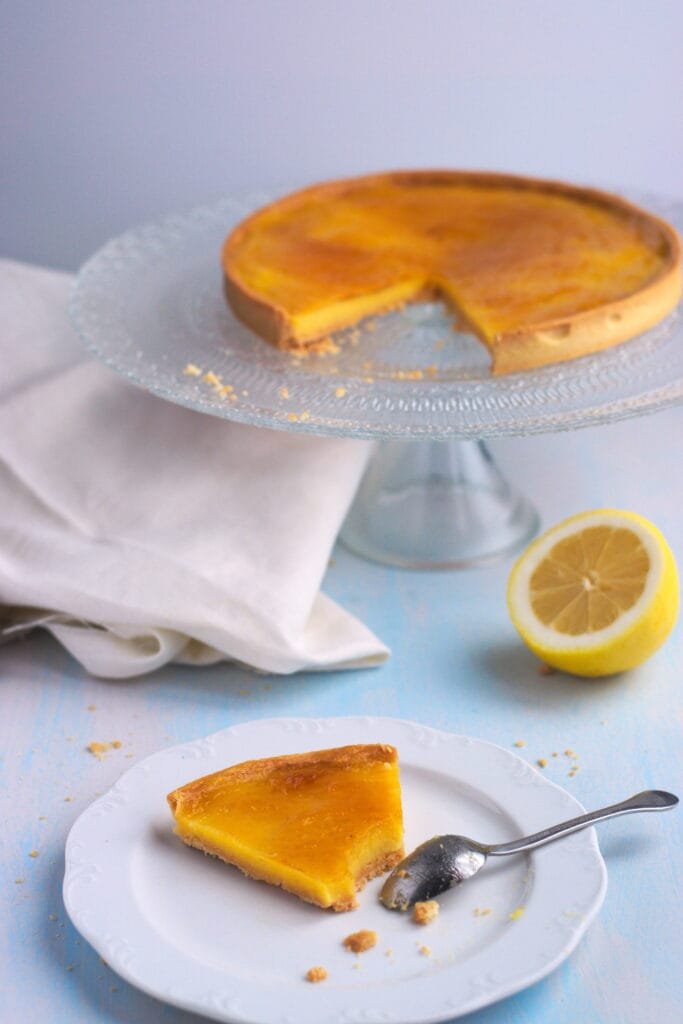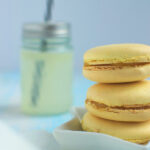As I promised in the last post, here it is at last, the recipe for CAP lemon tart. It’s been a busy week. In fact, I’ve been neglecting my pen a little lately. Between projects linked to my new business and aligners to correct my teeth, baking has clearly taken a back seat. For those wondering what this has to do with anything, I’m supposed to brush my teeth every time I put my aligners back in. So I’m on average brushing my teeth 6 times a day. This confers certain advantages (I must have the cleanest teeth in France), but it’s a bit complicated when it comes to tasting my recipes.
I’m also in the middle of a reflection phase. CAP recipes are a bit of a trademark of mine, but I’m getting a bit bored of doing the whole program over again. I’m really allergic to routine and sometimes I’d like to let loose with more original, less structured recipes (like my strawberry-rhubarb tart, for example).
Aside from that, I’ve been getting more feedback lately on “peripheral” CAP issues (which I guess are less covered elsewhere) than on recipes. So don’t hesitate to let me know in the comments what you like here and what subjects you’d like to see more of (well, if you’re replying with recipes for hacks using hyper-chemical commercial products, clearly that’s not going to be possible ^^).
I’m also wondering whether I should start making videos (today’s lemon tart was supposed to be one, but publishing the top of my skull wouldn’t have been much help!). I admit I’ve been putting it off for a long time, given the time it takes to produce a video. But if it turns out that you’re looking forward to it (or not at all!), don’t hesitate to let me know what you think.
How to make the lemon tart
So, back to the CAP lemon tart. Um, clearly the whole point of the recipe is the lemon cream (if you’re familiar with fonçage, of course, otherwise you can find the detailed instructions for the CAP apple tart). What to do to avoid lumps, when to add the butter (if there is any) and how to spread it to avoid spatula marks. But first, a quick recipe point.
Which pastry for a lemon tart?
Lemon tarts can be made from 2 different types of pastry. Sweet dough or shortbread dough. Shortbread dough is a crumbly dough, which contains more butter and sugar than its counterpart. Both recipes are available in the technical datasheets, but I believe that shortcrust pastry is in the majority. This recipe uses a sweet pastry (you can find the recipe in the article).
How do you make lemon curd?
So, first step to making lemon cream: place half the sugar and lemon juice in a saucepan and heat. In a separate bowl, beat the eggs, cornflour (or cream powder, depending on the recipe) and remaining sugar, but do not whisk.
When to add the butter?
For the butter (if the recipe contains it), there are apparently several techniques. I’ve always learned to incorporate it in small pieces after cooking, but you can also melt it with the sugar and lemon. This is much less common, it seems to me.
When the mixture begins to simmer. Pour over the egg/sugar mixture and return to low heat, stirring constantly. Like custard, it will thicken as it cooks. Sometimes the whites coagulate a little during cooking, forming filaments in the cream. If this happens to you, don’t panic: a quick whirl with the immersion blender and your lemon curd will be smooth.
It’s at this point that I recommend adding the butter, when the cream has cooled a little and the butter will thicken it. The pieces of butter should be small enough (around 20 g) to blend well with the lemon mixture. The result is a smooth cream that can be poured over the white-baked tart shell. And now, ladies and gentlemen, comes the delicate moment of smoothing the lemon cream.
Smooth the lemon cream
So there are two solutions: at home, I advise you not to touch it and to turn the tart base to distribute the cream. Sometimes it’s a bit hot because the lemon cream is a bit thick and doesn’t spread well, so you finish with a spatula. A teacher told me that in CFA, they use large sieves to even out the cooked tart base. That way, all the edges are at the same height, and you just smooth them out with a single stroke of the spatula. Apparently, the result is perfect (but I’ve never tried it).
Then simply top with neutral glaze for a shiny result. To do this, boil neutral topping in a saucepan. Depending on the brand, it may or may not need to be diluted with water. Then simply brush it over the tart for a shiny finish. For a CAP-style lemon tart, we should now tackle the writing on the cone, but that will be the subject of a future post.
And if you like lemon tart (or especially if you don’t!) find my recipe: lemon tart for those who don’t like lemon tart!


Tarte au citron CAP patisserie
Équipement
- Un cercle à foncer de 20 cm
- Un cul de poule
- Une casserole à fond épais
- Du film alimentaire
Ingredients
Pâte sucrée
- 200 g de farine T55
- 100 g de beurre
- 80 g de sucre glace
- 40 g d' œuf entier battu
Crème citron
- 80 g de jus de citron
- 200 g d’œufs entiers battus
- 125 g de sucre
- 10 g de poudre à crème
- 2 de zestes de citron
- 125 g de beurre
Instructions
Pâte sucrée
- Dans la cuve du robot ou à la main, mélanger le beurre et la farine. Ajouter le sucre glace et l’œuf battu (dont on a prélevé 40 g).
- Pétrir et s'arrêter dès que la pâte est amalgamée (pour éviter de trop faire travailler le gluten). Faire une boule, l'étaler en grosse galette, la filmer et la placer au frigo pendant au moins 20 minutes.
- Après le passage au frigo, sortir la pâte et la laisser revenir à température 5-10 minutes. Elle doit pouvoir être étalée sans casser. Quand la pâte est étalée sur 2 mm d'épaisseur, foncer un cercle à tarte en prenant garde à bien créer un angle droit dans le fond. Percer le fond de tarte à l'aide d'une fourchette.
- Remettre le fond de tarte au frigo pendant 20 minutes puis le cuire à 180° pendant environ 20 minutes (la pâte doit être légèrement dorée). A la sortie du four, égaliser les bords soit à l'économe soit avec un très large tamis.
Crème citron
- Faire chauffer le jus de citron et la moitié du sucre dans une casserole à feu doux. Dans un récipient à part, mélanger les œufs, le sucre, la poudre à crème et les zestes de citron.
- Lorsque le jus commence à frémir, l'ajouter au mélange sucre-œufs et mélanger. Remettre à feu doux en remuant constamment. La crème va épaissir. Lorsqu'elle atteint la consistance d'une mayonnaise, retirer du feu. Passer un coup de mixeur plongeant si la crème contient des grumeaux.
- Attendre quelques minutes et intégrer le beurre en morceaux. Puis verser sur le fond de tarte cuit à blanc. Faire chauffer du nappage neutre et étaler au pinceau pour faire briller.





![Rose tarts [concours] 17 rose tarte camille patisserie3](https://camille-patisserie.com/wp-content/uploads/2016/04/rose-tarte-camille-patisserie3-150x150.jpg)